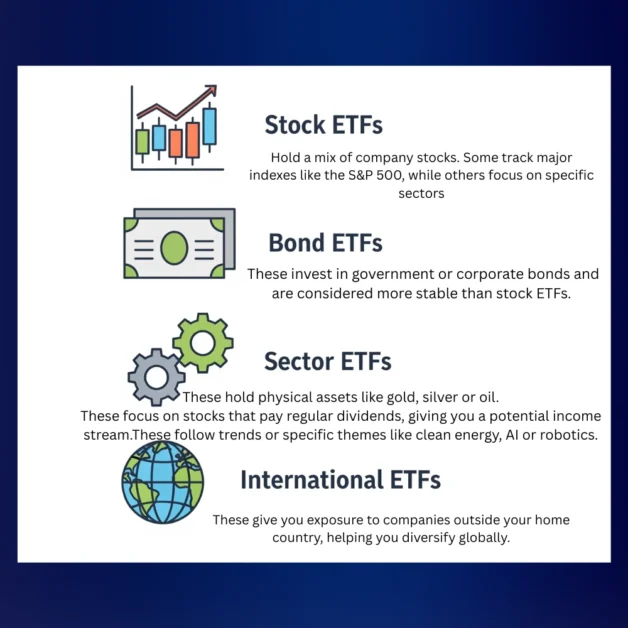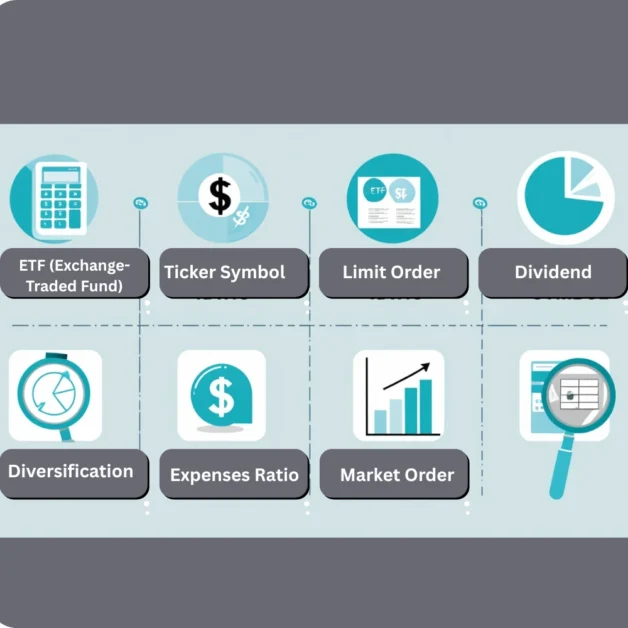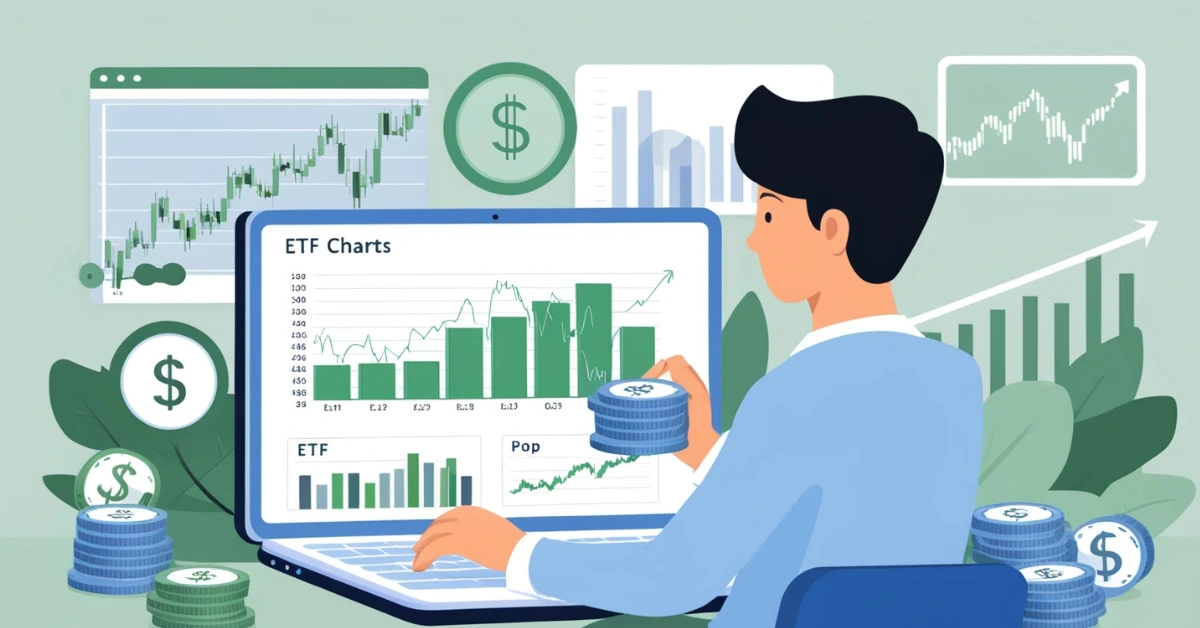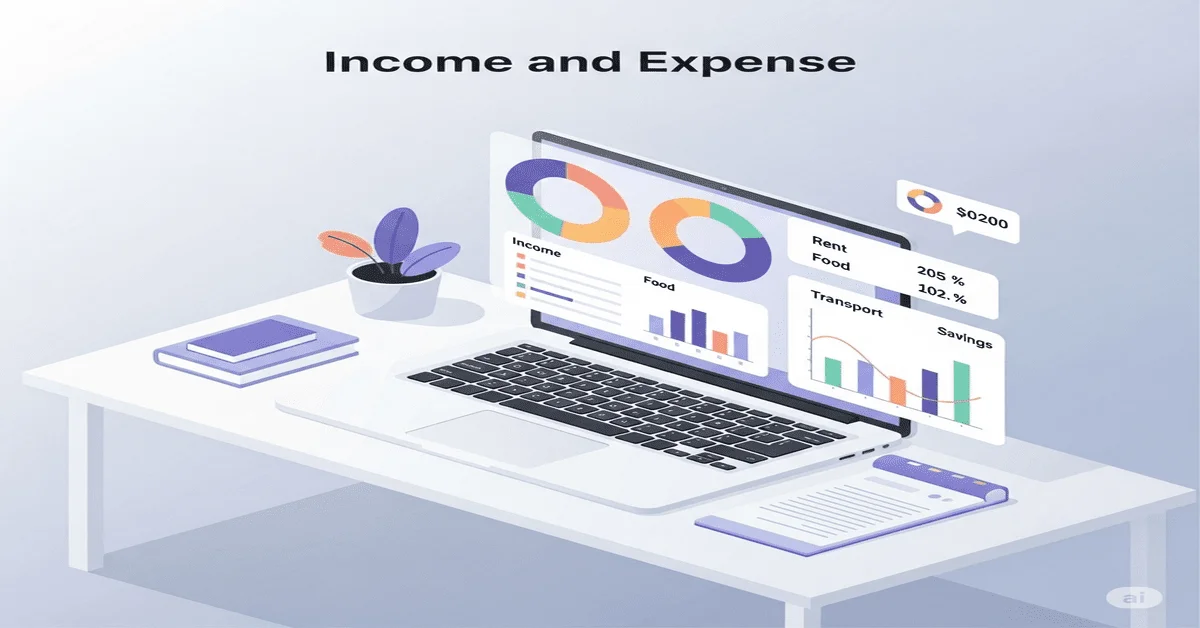Investing can feel overwhelming when you’re just starting out. With so many options out there stocks, mutual funds, real estate then it’s hard to know where to begin. If you’re looking for a simple, low cost way to dip your toes into the world of investing, ETFs might be your best starting point.
What Is an ETF?
ETF stands for Exchange Traded Fund. It’s a type of investment fund that holds a collection of assets, such as stocks, bonds or commodities. Think of it like a basket filled with different types of investments. When you buy a share of an ETF, you’re buying a tiny piece of that entire basket.
What makes ETFs special is that they are traded on stock exchanges, just like individual company stocks. That means you can buy or sell them anytime the stock market is open.
Types of ETFs
There are many types of ETFs to choose from, depending on your investment goals. Here are some of the most common ones:
- Stock ETFs: These hold a mix of company stocks. Some track major indexes like the S&P 500, while others focus on specific sectors like technology or healthcare.
- Bond ETFs: These invest in government or corporate bonds and are considered more stable than stock ETFs.
- International ETFs: These give you exposure to companies outside your home country, helping you diversify globally.
- Commodity ETFs: These hold physical assets like gold, silver or oil.
- Dividend ETFs: These focus on stocks that pay regular dividends, giving you a potential income stream.
- Thematic ETFs: These follow trends or specific themes like clean energy, AI or robotics.
Why Are ETFs a Good Choice for Beginners?
ETFs are a popular choice for new investors for several reasons:
- Diversification: One ETF can hold dozens or even hundreds of different stocks or bonds. This spreads your risk across many companies rather than relying on just one.
- Low Cost: Most ETFs have low management fees because they’re often passively managed, meaning they track an index rather than being actively picked by a manager.
- Easy to Buy and Sell: Since ETFs trade like stocks, you can buy and sell them through a regular brokerage account.
- Transparency: You can easily see what’s inside an ETF, so you know exactly where your money is going.
- Accessibility: You don’t need thousands of dollars to get started. Many platforms allow you to invest with as little as $10 or even less.
Key Terms to Know Before Investing
Before diving into ETF investing, it’s helpful to understand a few basic terms. These simple definitions will make the process clearer and help you feel more confident.
| Term | Simple Meaning |
|---|---|
| ETF (Exchange-Traded Fund) | A group of investments you can buy/sell like a stock |
| Ticker Symbol | Short code used to identify an ETF on the stock market |
| Expenses Ratio | Annual fee taken by the fund (lower is better) |
| Market Order | Buy the ETF at the current market price |
| Limit Order | Buy only if the ETF hits your chosen price |
| Dividend | A payment some ETFs give you from profits of companies inside it |
| Diversification | Spreading your money across different assets to lower risk |
Steps to Start Investing in ETFs
Starting your journey with ETF investing is simpler than it seems.You don’t need to be a finance expert or have a lot of money to begin. With just a few simple steps, you can start building a strong investment foundation that grows over time. Here’s how you can start investing in ETFs the smart and easy way.
Set Your Financial Goals
- Think about why you want to invest.
- Are you saving for retirement?
- Do you want to build wealth slowly over time?
- Are you trying to earn passive income?
Knowing your goal helps you choose the right type of ETF.
Choose the Right Brokerage Account
To buy ETFs, you need a brokerage account (an online investment account).
- Look for platforms with no or low fees, an easy to use interface and good customer support.
- Examples: Local banks, investment apps or online brokers (many are beginner friendly).
Fund Your Account
- Once you’ve opened your brokerage account:
- Link your bank account
- Transfer some money into your brokerage
You don’t need a lot of money just starting with just $50 or $100 is possible.
Research and Choose the Right ETFs
Don’t just buy any ETF also look into a few key things:
- Expense Ratio: A small yearly fee taken by the ETF to manage your investment. The lower it is, the more of your money stays invested (typically ranges from 0.03% to 0.15%).
- Performance: This shows how well the ETF has grown in value over the past few years. It helps you understand its past result but remember, past performance doesn’t guarantee future returns.
- Performance: How has it done over the past few years?
- Risk level: Does it go up and down a lot? Or is it more stable?
If you’re just starting out, look into broad market, low cost ETFs, such as those that follow the S&P 500 which includes top U.S. companies.
Decide How Much to Invest
There’s no need to put all your money in at the beginning.
- Start small
- See how the market works
- Gradually invest more when you’re confident
Many ETFs allow fractional shares, so even small amounts count.
Place Your Order
Now you’re ready to buy your first ETF.
Steps:
- Search for the ETF’s ticker symbol (like VOO, QQQ, SPY)
- Click “Buy”
- Decide how much to invest: You can either enter the number of shares or simply the amount you’d like to spend.
- Pick your order type
- Market Order: Buys the ETF right away at its current price.
- Limit Order: Buys only when the ETF reaches the price you set.
- Keep an eye on your investment: Track how it’s performing, but don’t worry about daily ups and downs.
Monitor Your Investment
Once you’ve invested:
- Track your ETF’s performance using your app or account
- Don’t panic if prices go up and down
- Stay focused on long term goals
Keep Investing Regularly
- The best way to build wealth over time is consistency.
- Try monthly investing even with small amounts
- This is called dollar cost averaging and it helps reduce risk over time
Rebalance When Needed
Every few months or once a year:
- Review your ETF portfolio to ensure it still aligns with your financial goals.
- Adjust if needed ( sell one ETF and buy another)
Tips for Successful ETF Investing
Here are some simple tips to help you get the most out of your ETF investments:
- Start with what you have: You don’t need a big sum begin with any amount you’re comfortable with and grow it over time.Stay consistent: Try to invest regularly, even if it’s just a small amount each month.Focus on the future: ETFs are best for long-term goals. Don’t worry about short term market ups and downs.Watch the fees: Lower expense ratios mean more of your money stays invested. Always check before you buy.
Spread your risk: Don’t put everything into one ETF. Choose a mix across sectors or asset types to stay balanced.
Risks to Be Aware Of
No investment is without risk and ETFs are no exception. Some potential risks include:
- Market Risk: If the market drops, the value of your ETF will likely fall too.
- Sector Risk: If you invest in a sector-specific ETF and that sector performs poorly, your investment will suffer.
- Tracking Error: Some ETFs don’t perfectly mirror the index they aim to follow. This may cause small variations in how the investment performs.
- Liquidity Risk: Some lesser known ETFs have low trading volume and making them harder to sell at a good price.
Understanding these risks can lead to better investment decisions.
FAQs
Q1. What is an ETF in simple words?
A: An ETF (Exchange-Traded Fund) is a bundle of investments like stocks or bonds. You can buy and sell it like a stock, and it helps you spread your money across many companies with just one purchase.
Q2. Do I need a lot of money to start investing in ETFs?
A: No! You can start with as little as a few dollars, especially if your brokerage offers fractional shares. Many beginners start small and grow over time.
Q3. Are ETFs safe for beginners?
A: While all investments have some risk, ETFs are considered safer for beginners because they are diversified and usually have lower fees. Broad-market ETFs are especially beginner-friendly.
Q4. What’s the difference between ETFs and mutual funds?
A: ETFs are traded like stocks throughout the day, often have lower fees, and don’t require a high minimum investment. Mutual funds are priced once daily and may have higher costs or entry requirements.
Q5. How do I choose the right ETF?
A: Look at:
- What the ETF invests in (stocks, bonds, sectors etc.)
- Its expense ratio (lower is better)
- Past performance (though not a guarantee)
- The reputation of the fund provider (like Vanguard, iShares)
Q6. Can I lose money with ETFs?
A: Yes. Like all investments, ETFs can go up or down in value. However, because they are diversified, the risk is often lower than investing in individual stocks.
Final Thoughts
ETFs offer a simple and smart way for beginners to start investing. They offer diversification, low costs and simplicity all key features for anyone new to investing. Whether you’re saving for retirement, a big purchase or simply want your money to grow over time, ETFs provide a flexible and accessible way to start building your portfolio.



